
Watercraft Part 4: First Find Your Carp
Share
There is a saying in carp fishing that goes something like, find 'em, feed 'em, catch 'em.
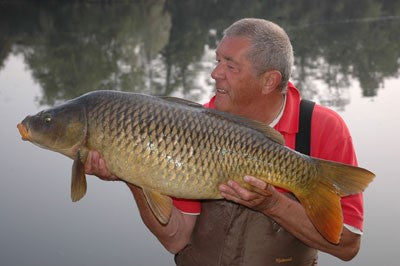
The second and third aspects of that mantra are pretty straight forward; it is the first part than many newcomers to carp fishing find difficult! as my title suggests, before you can catch them you have to find them and basically the art of watercraft is primarily all about doing just that. Frankly, nothing accounts for a blank as much as being in the wrong place at the wrong time. But how do you tell if you are in the wrong place? Well, observation and location are inextricably linked and as I have said before, keeping a close eye on the lake is a vital part of obtaining knowledge of the carp’s whereabouts.
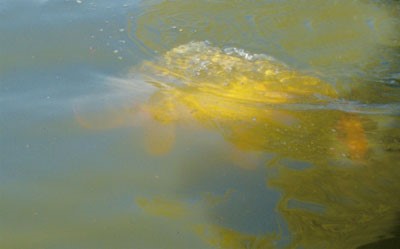
I feel very confident when I see carp head and shouldering over my bait carpet, but I also use these signs of feeding activity to help me locate carp in the first place, particularly if I think it unlikely there is any anglers bait where they are showing. Fish that just stick their head and slip back under without a sound are feeding fish and if they are not feeding on bait then they are eating natural food items such as mussels. or crayfish.
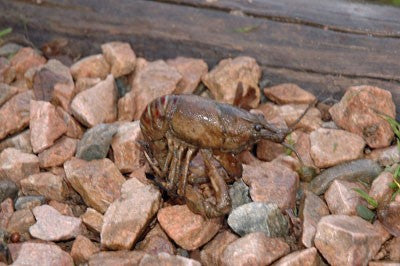
All forms of invertebrate life, such as this crayfish reveal their presence by the amino acid they release as the feed, breath and excrete. Carp detect these natural food messages and they will visit and re-visit a natural food larder time and time again. In addition carp often display over lakebed features such as plateaux, shallows, gullies or bars that harbour silt because if you can find the silt, you will also find invertebrate life and ergo the carp!
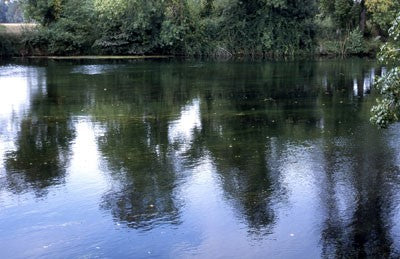
A lot of beginners get their knickers in a twist when confronted by silt but there is no need. That is where the food is so that is where the carp will be. It's simple really yet many folk spend too many hours worrying about silt, when in fact they should be actively looking for it, not avoiding it. One of my passions is fishing for carp in rivers. You might think that the current would wash away much of the silt on the river bed, but in fact silt gathers in slacks and eddies and on the inside of bends if you know where to look it makes finding river carp - a harder job than finding them in lakes - a lot easier.
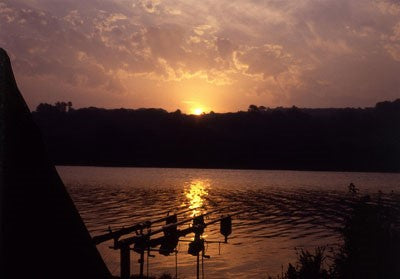
When we first started fishing this large reservoir back in the day we used short 4-inch hooklinks and three-ounce bombs. We hadn’t a clue how to find features properly so we just chucked the baits out to where we has seen fish showing. Pretty unscientific, I am sure you'll agree, but they were showing there for a reason and that reason was food!
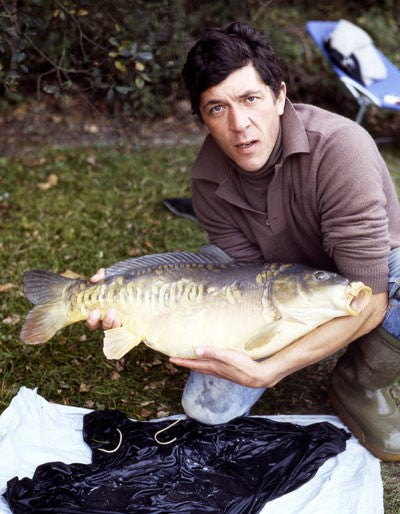
Despite our relative ignorance we actually caught fish. Pure serendipity! It wasn’t until a few years later, when I went out for a bit of a swim that I discovered we had been chucking our hookbaits into 2 feet of soft silt and they must have been dragged way down beneath the surface layer of silt but that didn’t stop the carp from finding them!
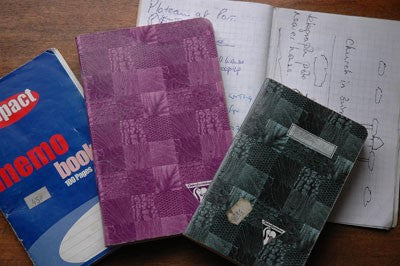
There is a huge temptation to think that once you have found a hot spot that it will remain so indefinitely. Like any larder an area of natural food can become exhausted and the carp will move on. You should always be ready to move with them if an area shows signs of dying on you, but don’t forget that just as a larder may become empty, so it may well refill the following year. It’s a good plan to keep a notebook to record as much detail about a venue as possible, based either on your own observations and catches, or on information given by others. It is also a good idea to note any sightings of fish including those caught by others. I am not suggesting that you spy on your fellow anglers but noting what swims are producing, and how they are being fished will do your own chances no harm. Just be surreptitious about your activity!
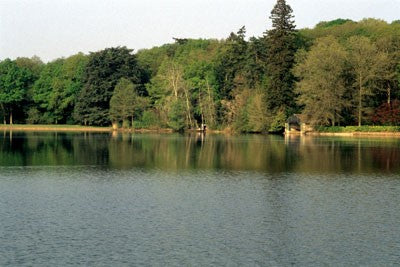
Once you get to know a venue well, you may be tempted to fixate on one particular swim, regardless of conditions or how it has been fishing To my way of thinking it is always a big mistake to travel to a lake with only one swim in mind, as pre-selecting a swim in your head can let you down. The Boathouse on the Chateau Lake is my favourite swim and when conditions are right you can really bag up in it. But sometimes pre-selecting a swim before you start fishing can really kick you up the backside.
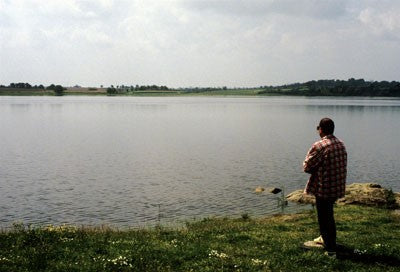
On arrival most good anglers will walk around a water before deciding where to fish. They take the time to really look at the water and assess how the weather conditions might be affecting each area of the lake. Personally speaking, the less I know about a water, the longer I spend walking the banks trying to build up a picture of the lake and how its carp might react.
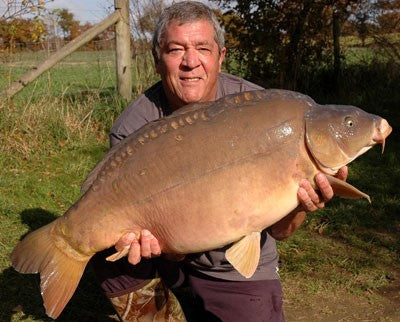
The more familiar you are with a venue, the easier it is to take it for granted. I am as guilty as the next man and as I have got older I have also become a lazy bugger. However, when push comes to shove and a move seems inevitable, even I will up sticks and move. Only a change of swim at Le Queroy saved me from an ignominious blank in a swim I have always regarded as my “banker”.
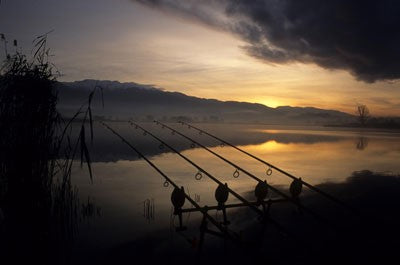
Now all this talk about finding fish when it’s lovely and sunny and the fish are on the move and feeding like crazy is all very well but what about in the depths of winter when they are interested not showing and the lake seems lifeless, as in the photo? This photo was taken on a cold January day on a lake near Rome. It make you feel cold just looking at it and I'll be the first to admit that location is a real challenge in conditions like this.
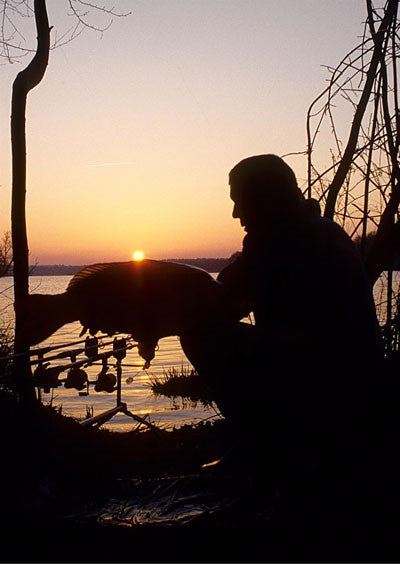
Successful winter carp fishing revolves around the amount of warmth at hand, both above and below the lake surface. Find areas of slightly warmer water or take advantage of weather conditions to find sheltered, shallow water, its surface kissed by winter sunlight and you are in with a chance. The amount of light, heat and warmth generated by the winter sun, though poor, can have an effect on fishing, particularly on shallower lakes. Even on the shortest day, the effect of the sun shining into a shallow bay, protected from chilling winds by tall trees or woods, can raise the water temperature by a degree or two, just enough to encourage carp to feed.
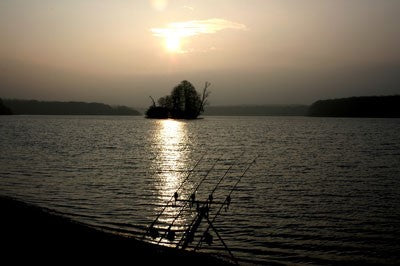
You hear a lot about how the weather will influence carp movement and you are told, “Follow the wind”. That may be all fine in high summer but I do not believe that wind strength and direction is anything like as important in winter as it is in summer and at times a cold wind can be the kiss of death. This is a photo of the kiss of death. Bet you didn’t think such an abstract concept could be photographed, did you? Well, I can assure you that on virtually all the lakes I know a bitter easterly wind is definitely that fatal kiss! Though not strong the wind blowing here is due east and like all easterlies it comes up and goes down with the sun. As you can see, at sunrise as seen here, the wind is cutting like a knife.
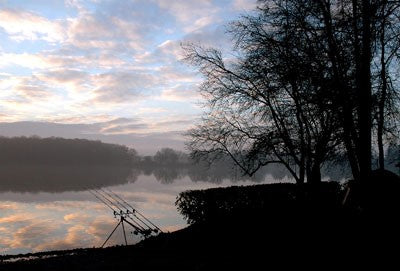
Fishing during the period as winter turns to spring is one of the most difficult times of the year as changing sunlight affects the water temperatures in different ways. Depending on the surrounding contours south-facing lakes as seen in this photo, will receive sunlight along their northern shoreline and even weak sunlight will have an effect, especially if the water is shallow.
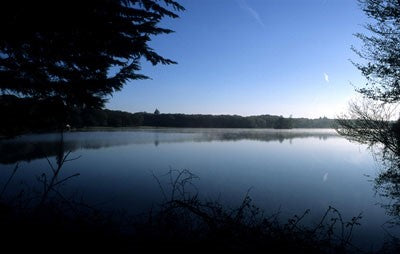
Even the weakest sun will cause the water temperature to rise, and no matter how small that rise may be it can trigger a feeding spell. Generally speaking anti-cyclonic weather conditions are more suitable, as they usually bring bright sunshine and not too much breeze. To me the amount of sunshine is paramount, which is why I favour any conditions that permit sunlight to penetrate the water and a still calm surface allows greater penetration than one kicked up by a chop.
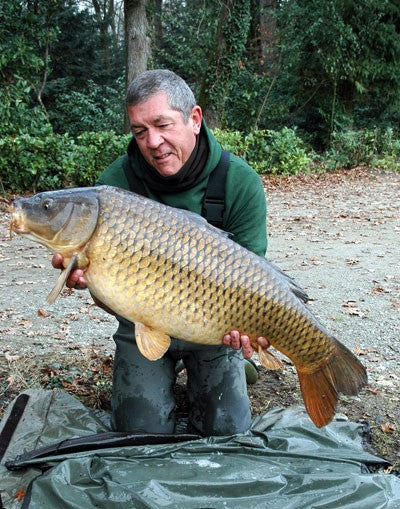
Any localised increase in water temperature can often trigger a brief yet very intense feeding spree. This is one of eight thirties caught in a 4 day period in late December. They all came from a shallow area off the main body of a 180-acre lake when the air temperatures were as low as minus 6 but the air temperatures rose to a balmy 12 degrees. The fish really came on the feed like it was summer time!
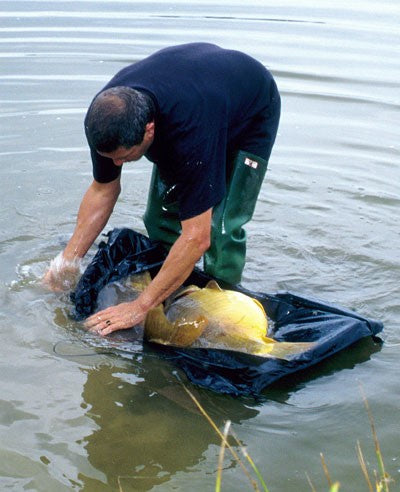
Similarly really warm winds, especially if they blow for several days, will also bring about that localised increase in water temperature that can get the carp feeding. So keep your eye on the weather broadcasts and when you see those isobars coming up from way down south, that’s the time to head for the lake. You never know, you could land a brace of thirties!

Winter frost and ice is obviously something we all have to contend with. If the lake is frozen over only the real die-hards cut holes in the ice and go fishing. Fresh water is at its most dense at 4 degrees Celsius, though it remains a liquid and does not become a solid (by turning to ice) until the temperature falls to zero degrees. This means that ice is less dense than water at just above zero, which is why it floats on the surface. Slightly warmer, denser water remains under the ice so carp, and other plants and animals are able to survive below the ice. In addition the ice forms a barrier between the colder air and the slightly warmer water so any inclination for the ice to spread downwards is slowed. Only in exceedingly shallow lakes, during the most extreme cold will lakes freeze right to the bottom.
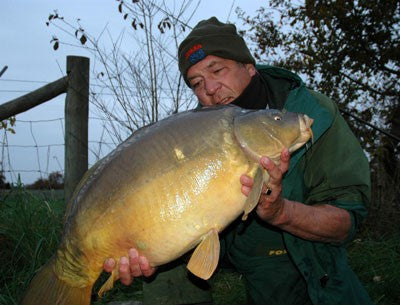
We should also look at the part oxygen plays in the overall picture. Carp extract oxygen from their surroundings via their gills and they survive low temperatures because their metabolism is slower so they use up less oxygen. They are also helped by the fact that cold water will retain more dissolved oxygen than warm. When water is at its most dense one litre of water is capable of sustaining almost twice as much oxygen than water at a temperature of 20 degrees Celsius. This indicates that even in the depths of winter as per the previous photo, there will be a surfeit of oxygen throughout the various zones of the lake. This in itself can generate a brief feeding spell, as this winter twenty shows.
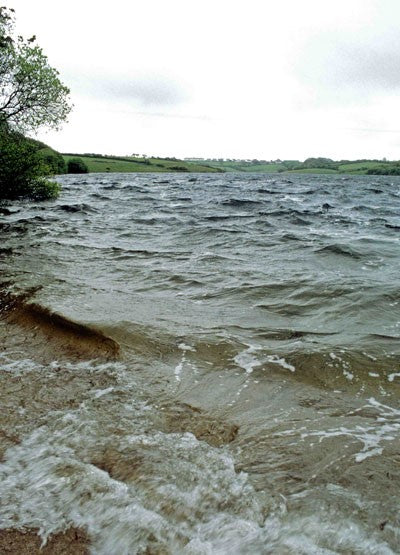
Quite the opposite applies in summer when high water temperatures are incapable of sustaining winter's levels of oxygen. In summer water is oxygenated by strong winds and wave action, which is why I prefer strong winds in the summer but not in the winter.
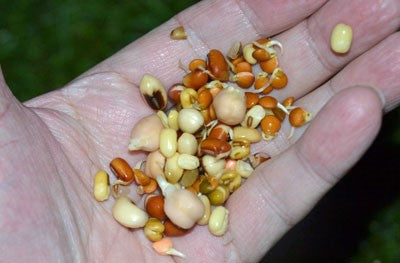
Hand in glove with visual observation goes actual location of feeding fish and the best way of doing this is to use the margins to your advantage, especially shallow margins where bait that you introduce can still be seen where it lies on the lake bed. Sprouted pulses and seeds are virtually instant in terms of attraction and they will soon be eaten by any carp that is patrolling the margins. Bait up several spots and visit them in turn over the course of, say, an afternoon's reconnaissance. When you come across one of your spots where the bait has gone, that probably means that a carp has been feeding on it.
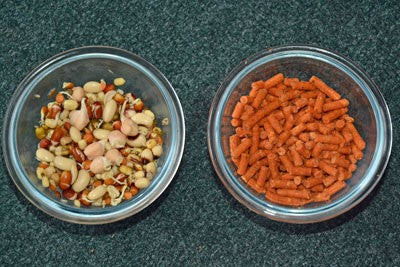
The faster you can force attraction into your baited area the more likely it is that carp will respond with similar swiftness. By adding some of our new SuperSoft, fast breakdown pellets to your particle mix you can flood the bated area with the enticing aromas given off by the pellets as they break down.
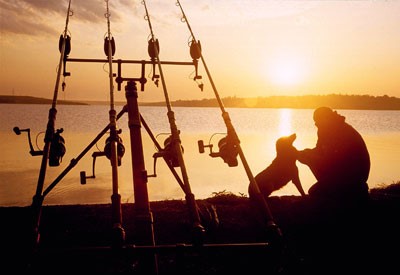
I hope you had a successful Easter weekend and managed to bank a few.
Until the next time, cheers...
Written by Ken Townley
